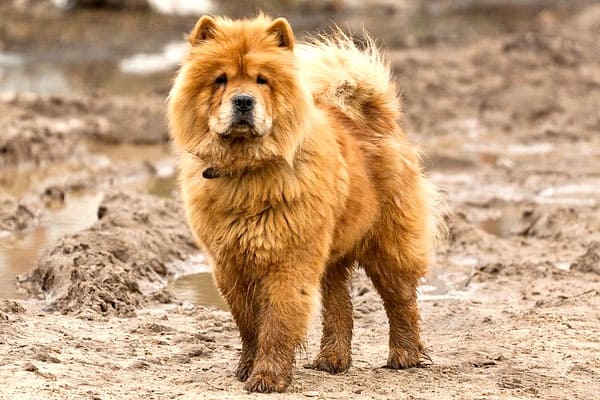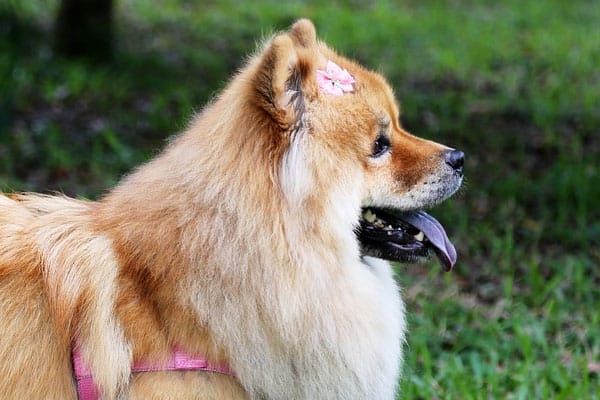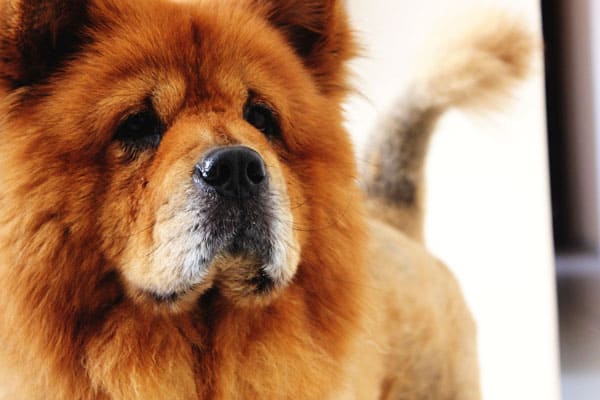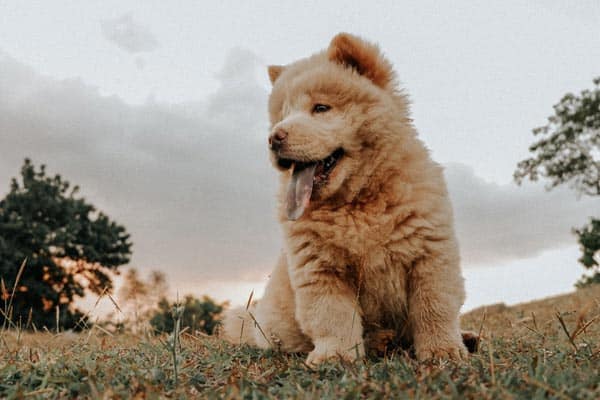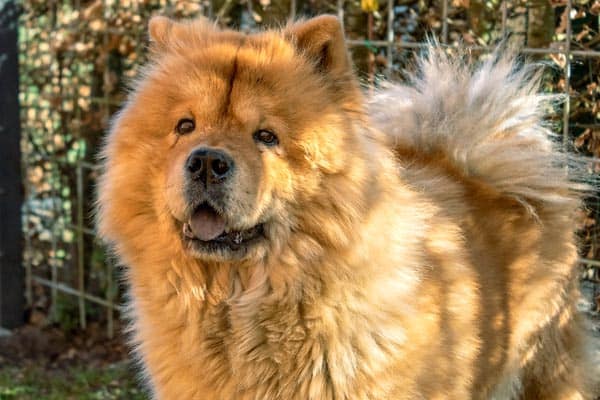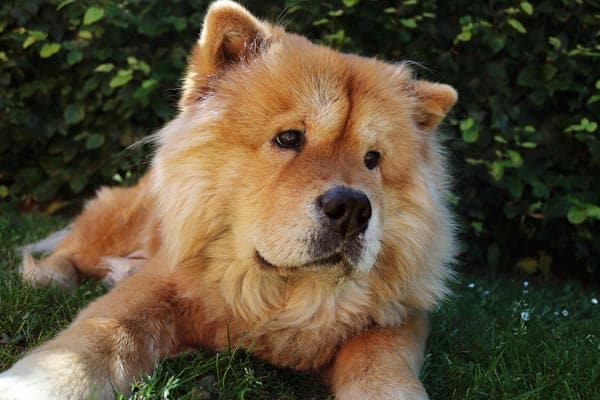Do Chow Chows Shed? Shedding Seasons and How to Cope with Them
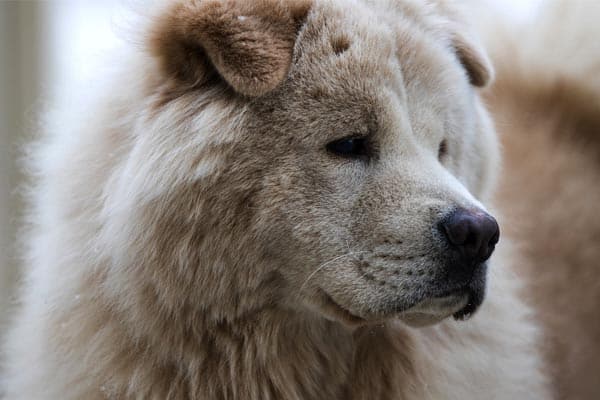
One of the pressing questions you will probably have when considering a new Chow Chow is how much shedding you should expect.
Do Chows Chows Shed Much?
Yes, Chow Chows are a high-shedding breed, so owners should be prepared for regular cleaning to manage the hair around their homes. They experience heavy shedding during the spring and autumn, known as “blowing their coat,” where they lose their thick undercoat.
Extra care and frequent brushing are necessary during these periods to maintain their coat’s condition. While grooming can help minimize shedding, Chow Chows will still shed year-round. Regular brushing and tools like shedding blades can assist in managing their shedding process.
What are the physical characteristics of the Chow Chow?
The Chow is a medium-sized dog in the Spitz family. It shares characteristics with the other family members, such as relatively small triangular ears, a dense dual coat, and a curled tail carried over the back. You would see more of a wedge shape to the large head if it was not snub-nosed.
Chows are unusual in that they have straight hind legs and a blue-black tongue, lips, and mouth. Chow Chows are 17 to 20 inches tall at the top of the withers and weigh between 40 and 70 pounds. Thus, they do not seem to shed as much as larger dogs like the Great Pyrenees.
Long-Haired Chow Chow
More appropriately referred to as the rough-coated Chow Chow, the long-haired typed has medium-long fur. The outer coat comprises straight hair that stands off slightly from the body, contributing to the dog’s poofy or fluffy look.
Chows have a prominent ruff around the neck that frames the face, giving them their famed lion appearance.
They also have “pantaloons” on the upper backs of the hind legs and feathers almost the full length of the front limbs. Some dogs also have feathers on the lower hind legs.
Adding further to the Chow’s fluffiness is an exceptionally dense woolly undercoat which is softer than the slightly coarse outer guard hairs.
Short-Haired Chow Chow
The smooth-coated Chow Chow has shorter fur that lies flatter than the rough-coated variety.
Although a smooth-coated Chow has the hint of a ruff framing its face, it is nowhere near as prominent as what you see on the long-haired type.
Smooth-coated Chow Chows also do not have feathers or pantaloons. However, they have an extremely dense woolly undercoat and shed in similar patterns to their rough-coated counterparts.
How is a Chow Chow’s coat type unique?
Whether you have a rough-coated or smooth-coated Chow, she has a specialized dual coat. The coat is designed to insulate dogs from the coldest temperatures in winter.
It also traps air currents effectively to protect the dog from moderate heat in the summer. Several dog breeds have this type of coat.
- Akita
- Samoyed
- Pomeranian
- Corgi
- German Shepherd
- Great Pyrenees
Other breeds have a dual coat of continuously growing hair that does not shed like the Chow Chow. It is also distinct from dogs with a single-hair coat like the Maltese. Double-coated-haired dogs have locks that grow to the ground unless you clip them.
- Lhasa Apso
- Shih Tzu
Because of the nature of its coat and how much it sheds, the Chow Chow is not a great hypoallergenic choice.
Do Chow Chows shed?
When a dog has a coat like a Chow Chow, the question is not whether it sheds but how much. A Chow continuously sheds medium-long to long guard hairs and loose hairs from the undercoat. Throughout most of the year, the Chow is a heavy shedder.
Your Chow will become an excessively shedding dog in the spring and fall. Shortly before summer, Chows shed copious amounts of their undercoat for a couple of weeks to replace it with a thinner layer of fur.
The process repeats itself in the weeks before winter; the not-quite-so-dense underfur shed and is replaced with thick woolly hair.
You will notice the fur coming out in multiple tufts during both shedding events. If you brush your dog, you can fill a 30-gallon garbage bag or more with hair daily.
Why do Chow Chows shed?
Chows shed because the nature of their coats is to turn over hairs often to provide the most protection against the elements.
Northern breeds have a dense pelt whereby the outer stiff guard hairs repel moisture from snow and ice, and the inner wool protects against the wind. Chows may be shed secondary to a variety of challenges.
- Coat neglect – loose hairs continue to accumulate, causing damage and more profuse shedding, and increased dry, flaky skin cells.
- Allergies – an allergic dog may scratch, increasing hair breakage, shedding, and dander.
- Skin conditions – increase skin and hair turnover
- Sunburn – increased hair loss
- Poor nutrition – unhealthy skin and hair are more commonly lost
- Stress – stress causes increased hair loss; make sure to socialize your dog to eliminate that as a source of stress
- Parasites – fleas will cause scratching, breakage, and hair loss; mange can cause direct hair loss
- Hormonal imbalances – hypothyroidism, pregnancy, Cushing’s disease
How can you help to shed in Chows?
While there is no way you can prevent your Chow Chow from shedding, there are steps you can take to minimize its effects on you and your home.
Why is shaving your dog a bad idea?
Owners are often tempted to shave their Chow Chow to alleviate suffering due to allergies or to decrease shedding.
Shaving a dual-coated dog with fur rather than continuously growing hair can be detrimental for several reasons.
- Renders the coat ineffective against both cold and warm weather – as a brachycephalic (short-nosed) breed, Chow Chows suffer in the heat as it is
- Leaves your pet vulnerable to sunburn; the less undercoat you leave, the more susceptible your Chow is to UV rays
- Shaving large areas can cause clipper burns, especially if clipping is extremely short; clipper burns can lead to hot spots and skin infections.
- Hair may never grow back the same – the outer coat becomes permanently damaged and may fail to return in some areas, leading to patchiness in the coat.
Clipping your Chow’s coat is ineffective for allergy sufferers because shaving increases rather than decreases dander.
Body clipping your dog likewise will not decrease shedding. Your Chow will shed shorter hairs and still change his undercoat in the spring and autumn.
Removing your Chow’s undercoat can temporarily decrease seasonal shedding, but the cost to your dog’s skin is not worth the risk. Lion and Teddy bear cuts on Chows are common to ease the burden of coat management.
Brushing is the most effective means to minimize the effects of shedding
The most effective way to decrease the effects of your dog’s shedding is to brush her regularly. Brushing your pet has a few benefits besides improving circulation to your dog’s skin.
- Distributes natural oils through the coat
- Removes a lot of loose furs before it ends up on the carpet or the furniture
- It facilitates the undercoat’s shedding and lets you control where that excess hair goes.
- It prevents matting and the entrapment of dirt, loose hairs, and dander
Brushing your Chow Chow at least thrice weekly would be best. You can reap even more benefits by brushing your dog every day.
To effectively brush your Chow, you need at least two or three different brushes or combs.
Slicker Brush
A slicker brush is an excellent essential brush for long-haired dogs. It can reach through a double layer of fur to remove debris, dead skin, and loose hairs near the skin.
The slicker brush is also a great detangling tool. If you brush every other day, you should not have any issues with tangles except possibly in the ruff and behind the ears.
Push the hair backward toward your dog’s head to expose the skin. This gives you a starting point for your slicker brush.
Make sure to grip the hair carefully below any tangles so you do not pull on your dog’s skin and hurt her. If there are no mats, use the same technique to get all the debris trapped in the undercoat.
Pin Brush
Some Chow owners prefer a pin brush to a slicker brush. Pin brushes are often better for dogs with shorter fur, such as the smooth-coated Chow Chow.
Its wire bristles can detangle like a slicker brush and remove hair and dander. Its bristles are often rubber-coated, which you can use to massage your pet’s skin.
Pin brushes also provide a nice finish to your dog’s outer coat because they do not create static. Remember that pin brushes may not penetrate both layers of a dog with longer fur. They come as standard brushes or grooming mitts.
Metal Comb
Unlike a de-shedding tool, a metal comb can remove mild tangles near the skin. It will also rid the coat of large debris particles such as leaves or clumps of dirt.
Metal combs are also suitable for creating a polished look, removing loose hairs that lie on the surface of your dog’s fur. When using a finishing comb, dampen the hair with a fine water mist or condition precisely for dogs.
Rake
A rake is more specific than a metal comb for underfur tangles. However, its best use is on the pantaloons of the rough-coated Chow Chow because it tends to thin the coat. You may not want your dog to lose too much hair on her body or from her mane.
Detangler
Detanglers can come in a comb with specialized serrated teeth or scissors with a built-in comb.
If you brush your Chow daily, you should not need a detangler often. Use a detangler sparingly because it will remove much of the coat you may want to preserve.
De-shedder
Specialized brushes like the Defurminator are specifically for the undercoat. They work remarkably when your Chow blows her underfur during seasonal shedding. De-shedders work similarly to rakes but are designed only to remove loose tufts of the undercoat.
Baths can support brushing to alleviate shedding concerns
Bathing a dog excessively will dry his skin and possibly increase shedding and dander.
However, bathing your Chow Chow once every four to six weeks can help keep loose hairs and flyaways under even more control between brushings.
Using canine shampoos and avoiding decisions centered around cheap products is essential. If you have access to a blow dryer, you remove more loose hairs.
Drying the fur completely is also essential to avoid damaging and breaking the hair shafts as you brush. You can also leave the baths to a professional groomer.
Supplements and de-shedding products help decrease hair loss
Improving the skin’s and fur’s health through supplements and conditioners will increase the hair’s suppleness and decrease brittleness, breakage, and loss.
- Omega-3 fatty acid supplements can be used in topical conditioners or oral supplements.
- De-shedding shampoos, conditioners, and leave-in topical treatments – a combination of oils and moisturizers help keep the coat clear of loose hairs and prevent the build-up of dander.
- Supplement thyroid hormones if warranted. Hypothyroidism in dogs is a common condition that dramatically affects the skin and fur, creating dull coats and sluggish hair follicles.
Examples
This is not a Chow but an Akita x Golden Retriever mix. His fur resembles a Chow, best illustrating what happens when a dual-coated breed blows its coat.
Blow drying your dog effectively removes dead fur from a shedding undercoat but will not substitute for brushing.
Always brush your dog before a bath and wait until she is almost dry before you use a brush afterward.
You can see down to the skin as this person moves the blow dryer. This is the spot you seek when you want to start brushing.
